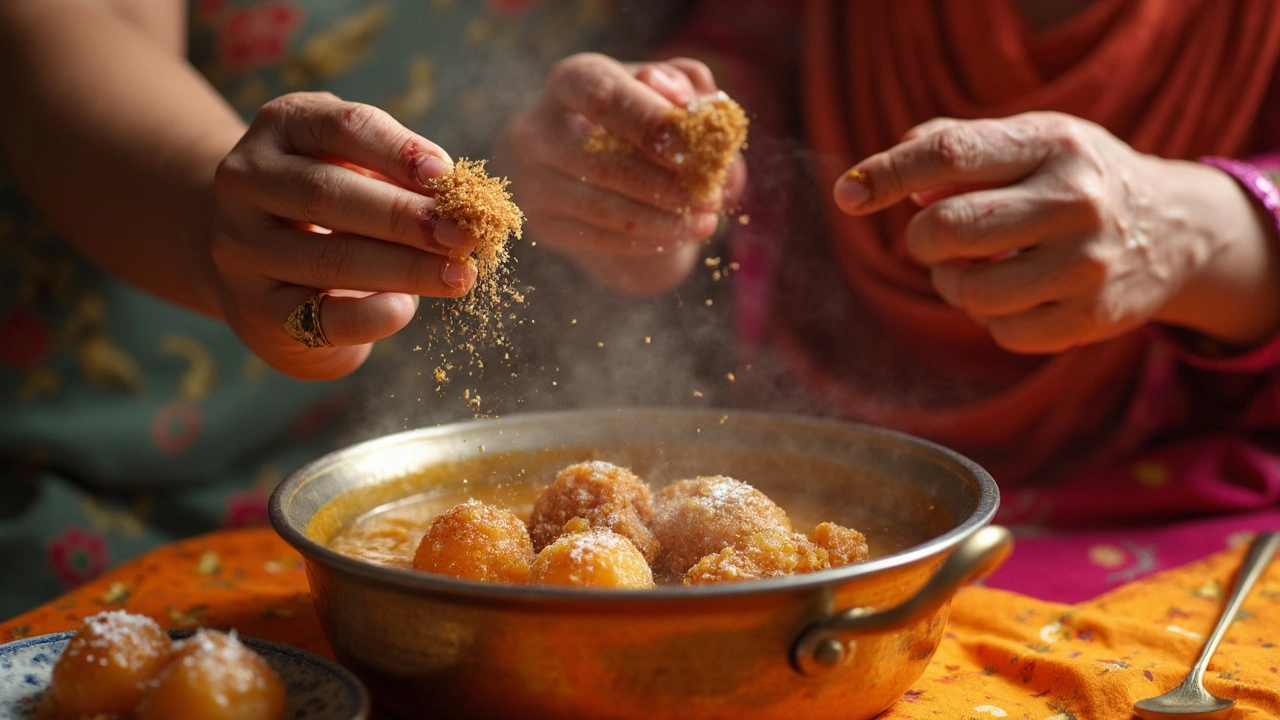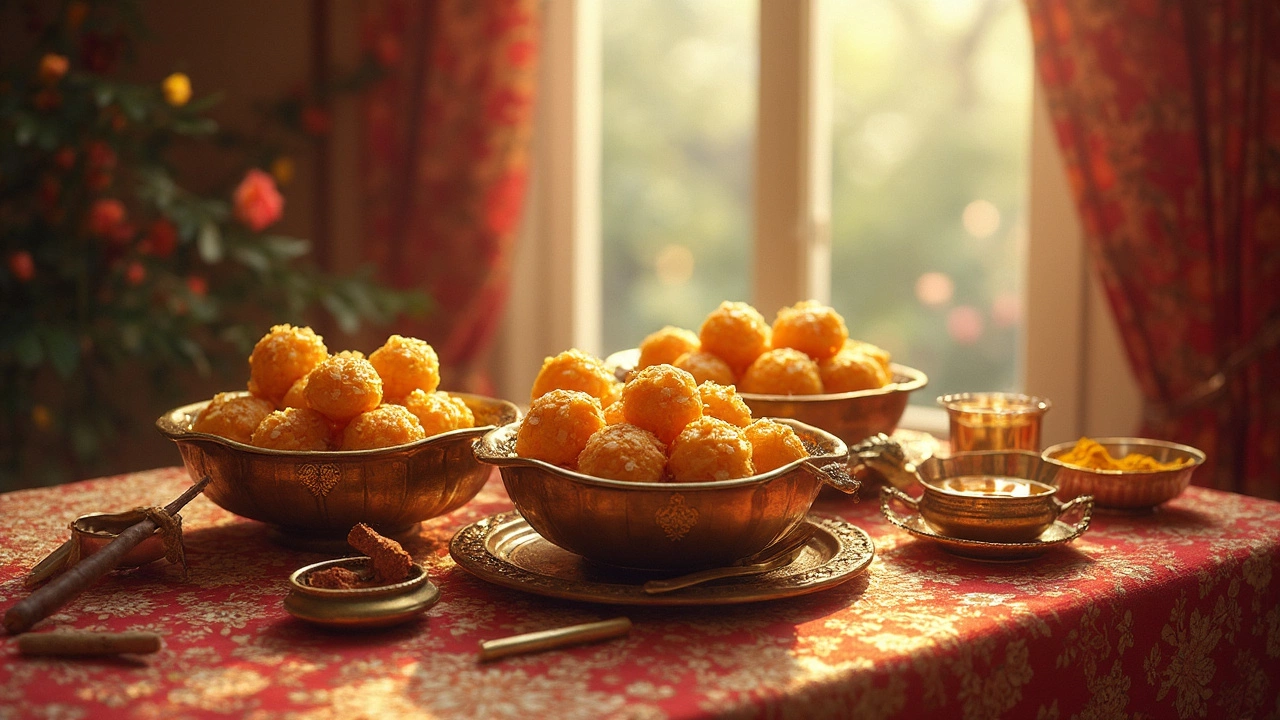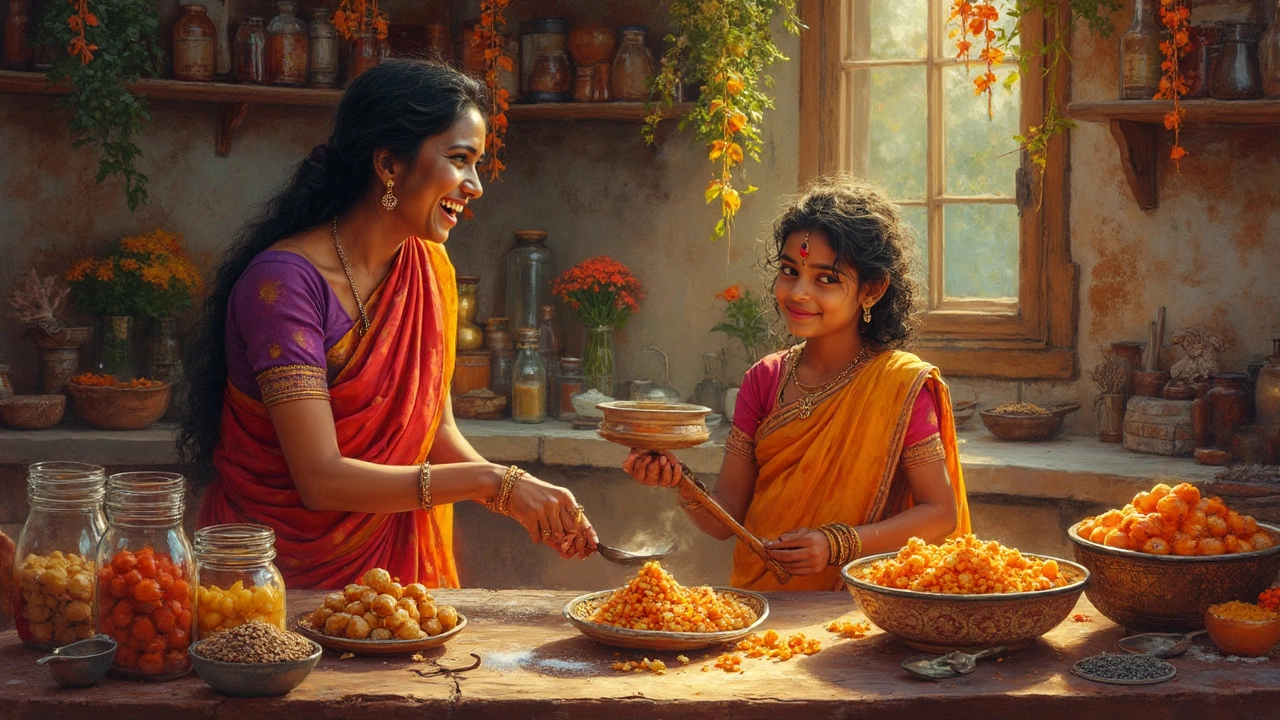If you think Indian food is all about spicy curries, you’re missing out on half the story. The sweet taste isn’t just for desserts—Indian cuisine has a thing for sweetness that pops up in the most surprising places. Ever had chana masala with a hint of sugar, or a spoonful of tamarind chutney that tastes sweet and tangy at the same time? That’s no accident. Cooks across the country use sweetness to make dishes feel special and well-rounded.
So, what’s behind this? It’s not just plain sugar. Indian kitchens have a whole line-up of sweeteners—jaggery, honey, palm sugar, dates, and sometimes even sugar cane juice. The choice of sweet stuff totally changes the flavor. And in sweets like gulab jamun or rasgulla, the sweet hit comes from fragrant syrups—think cardamom, rose water, saffron—each adding its own twist. If you’ve ever wondered how mithai gets addictive, this is why.
- Why Sweetness Stands Out in Indian Cuisine
- Common Sweeteners: From Jaggery to Sugar
- Sweet Surprises in Savory Dishes
- How Indian Sweets Get Their Signature Flavor
- Tips for Achieving Perfect Sweetness at Home
Why Sweetness Stands Out in Indian Cuisine
Sweetness is a signature note in Indian food, and it’s not just about making things taste good. For centuries, adding something sweet was a practical fix—sugar and jaggery help balance out strong spices and sourness from ingredients like tomatoes or tamarind. It’s a trick that stops your mouth from feeling too hot, too sharp, or too tangy. That’s why you’ll find a sweet touch even in dishes that aren’t desserts—think Gujarati dal or Bengali tomato chutney.
There’s also a cultural angle here. In India, sweet flavors are linked with good times, festivals, and welcoming guests. A meal doesn’t feel complete without at least a little bit of something sweet. People serve Indian sweets at special events, but even at home, a spoonful of sugar or jaggery can turn a regular dinner into a happy family moment. For kids like my son Aarav, a sweet bite at the end of a meal is the ultimate comfort.
If you zoom out a bit, you’ll see this trend all over India. Some regions are known for sweeter food than others. For example, dishes in Gujarat and West Bengal tend to be sweeter than those from, say, Kerala or Tamil Nadu. Here’s a quick table showing just how different it can be:
| Region | Famous Dish | Sweetener Used |
|---|---|---|
| Gujarat | Kadhi | Jaggery, sugar |
| West Bengal | Cholar Dal | Sugar |
| Maharashtra | Puran Poli | Jaggery |
| Punjab | Gajar Halwa | Sugar |
Historically, India has always had access to good sweeteners. India was one of the earliest places in the world to refine sugarcane, way before it spread to Europe. Old-school recipes passed down through families still use jaggery instead of refined sugar. Not to mention, Ayurveda, the traditional Indian medicine system, treats sweet taste as calming and nourishing. That's a big reason why sweet taste in Indian food feels so special—it's both comfort food and tradition in every bite.
Common Sweeteners: From Jaggery to Sugar
Walk into any Indian kitchen and you’ll probably find a few different kinds of sweeteners tucked into jars and bags. The most classic one is jaggery (gur). It’s made by boiling down sugarcane juice until it thickens into a sticky, golden block. What’s cool is jaggery has minerals that refined sugar doesn’t, like iron and potassium. That makes it popular in both North and South Indian sweets—think tilgul ladoo or payasam. Some people even use it in chai for a deeper, richer sweetness.
Refined sugar is everywhere these days, especially in Bengali desserts like rasgulla and sandesh, where the pure white color and smooth texture matter. Store-bought mithai shops usually go for regular sugar, basically for consistency and because it mixes well. Granulated sugar is perfect for syrupy treats like jalebi or gulab jamun, and it dissolves fast when you’re in a rush making a dessert for a festival.
Palm sugar and coconut sugar show up a lot in the South and along coastal regions. They taste a bit like caramel and blend well in food like Kerala’s ada pradhaman or Goan bebinca. These sweeteners are getting popular again for those looking for a less processed option.
Let’s not ignore honey, khoya (reduced milk), and even dates. Some modern recipes for Indian sweets now swap white sugar for date paste, especially for kids or people wanting something a little bit healthier. My son Aarav happily eats kheer made with jaggery or date syrup—no white sugar, no problem.
Here’s a quick look at some of the most common sweeteners you’ll find in Indian food:
- Jaggery (gur): Unrefined and mineral-rich, melts slowly, adds depth to sauces and sweets.
- White sugar: Dissolves easily, used for its clean, sweet flavor in desserts and syrups.
- Palm sugar & coconut sugar: More earthy, add color and subtle caramel-like notes.
- Honey: Used for twists on traditional sweets and for modern healthy mithai.
- Date syrup/paste: Popular in vegan or no-added-sugar recipes, gives a fruity hit.
Here’s a little comparison to show how sweet some of these are, gram for gram:
| Sweetener | Sweetness Level (vs. Sugar) | Extra Nutrients |
|---|---|---|
| White Sugar | 100% | Almost none |
| Jaggery | 70-80% | Iron, calcium, potassium |
| Palm Sugar | ~80% | Magnesium, potassium |
| Honey | 120% | Antioxidants, trace enzymes |
| Date Syrup | ~75% | Fiber, potassium, magnesium |
Getting the right balance is really about personal taste. Some folks love the deep, molasses-like flavor of jaggery, while others want things super-clean with white sugar. If you’re making Indian sweets at home, try swapping white sugar for jaggery or date syrup just once—you’ll notice the change instantly. It’s an easy way to make your treat a tad healthier without losing any of that classic sweet taste in Indian food.

Sweet Surprises in Savory Dishes
Most people don’t expect a sweet taste in Indian food to show up outside the dessert table, but it’s pretty common. All around India, you’ll find savory recipes that use something sweet to balance out the heat and tanginess. It’s hardly ever about making the whole dish sugary—it’s about creating a rounded flavor you’ll remember.
Take Gujarati dal, for instance. A classic bowl always has jaggery or sugar stirred in at the end to cut through the sourness of tomatoes and the punch from the spices. My son Aarav refuses to eat dal without that hint of sweetness—he calls it "dessert dinner" whenever we make it. Even street foods like chaat toss in a bit of date-and-tamarind chutney, so every bite is sweet, salty, spicy, and tangy all at once.
Want more examples? Here you go:
- Bengali Shukto: This veggie dish always adds a teaspoon or two of sugar or a small chunk of jaggery right before serving.
- Pav Bhaji: Vendors often sneak in a pinch of sugar to smooth out the flavors, especially when tomatoes are too tart.
- Vatha Kuzhambu: In Tamil kitchens, adding jaggery at the end helps soften bitter notes in this tangy tamarind stew.
- Korma: The creamy North Indian curry sometimes uses dried fruits or a dash of sugar to balance onion and yogurt.
Why do cooks do this? Sweetness takes the edge off spiciness, sharpness, and even bitterness. It rounds off flavors, making everything taste a bit more put together. There’s even a health angle: back in the day, a spoonful of jaggery in Indian recipes was said to cool the body in the hot summer.
Here’s a look at some common sweeteners and how often they pop up in Indian savory recipes:
| Sweetener | Typical Dishes | Common Regions |
|---|---|---|
| Jaggery (gur) | Dal, sambhar, kadhi | Gujarat, Maharashtra, South India |
| Sugar | Shukto, pav bhaji | Bengal, Mumbai |
| Date syrup | Chutneys, stews | North, West India |
So next time you notice a gentle sweetness in your curry, know it didn’t get there by accident. It’s a clever move that cooks have been using for centuries to get that perfect balance of flavors in Indian food.
How Indian Sweets Get Their Signature Flavor
If you’ve ever tasted a good gulab jamun or peda, you know there’s usually more going on than just a hit of sugar. The sweet taste in Indian food comes from a combo of ingredients and clever cooking techniques. First up, the main sweetener—usually sugar or jaggery—sets the base flavor. Sugar gives a clean, sharp sweetness. Jaggery (also called gur) brings a more caramel-like or earthy note, making the dessert taste deeper and sometimes a bit nutty.
It doesn’t stop there. The most popular Indian sweets also lean hard on milk and milk solids. Think of recipes like rasgulla, rasmalai, kalakand, and peda—here, milk is carefully reduced or even curdled into chenna or khoya. This gives the sweet a soft, creamy texture that melts quickly in your mouth. A lot of folks don’t realize this is why most Indian desserts feel a lot richer and heavier than, let’s say, a piece of cake.
- Spices: Cardamom is king, but saffron threads, nutmeg, or even black pepper pop up depending on the region. They lift the flavor and aroma, making ordinary sweets unforgettable.
- Fragrant ingredients: Rose water and kewra water are added by the drop, especially in North Indian sweets. These aren’t just for fancy fragrance—they balance the sweetness and keep things from tasting flat.
- Ghee: This isn’t just fat; it actually toasts and deepens the flavor. Think about biting into a hot ghee-laden ladoo—the sweetness feels warmer and cosier with it.
Cool fact: A 2024 survey by Indian Mithai Makers Association found that more than 85% of sweet shops use a blend of at least three types of flavorings per sweet, not counting sweetener. That’s a lot of thought into your barfi!
Some sweets rely on a floral kick, others go for rich dairy or nutty textures. If you’re making these at home, don’t skip the spices or fragrance water. They’re not just traditions—they’re what turn plain sweet dishes into real Indian sweets you crave year-round.

Tips for Achieving Perfect Sweetness at Home
Getting that spot-on sweet taste in Indian food at home isn’t hard, but it does need a few smart moves. Too much or too little, and your dish just doesn’t taste right. Here’s how to nail it every time.
- Start Small, Taste Often: Add your sweetener in small amounts. It’s easy to toss in more, but almost impossible to take sugar out. Taste as you go—especially when working with jaggery, since it’s sweeter than sugar.
- Pair With Tangy Stuff: Mix sweet with tangy ingredients like tamarind, amchur (dry mango powder), or lemon juice. That’s the trick behind chutneys and curries that feel balanced and not cloying.
- Choose the Right Sweetener: Jaggery or “gur” brings a rustic depth that plain sugar just can’t. For Indian sweets like laddoos, try mixing jaggery and sugar for layers of flavor.
- Watch Your Syrups: When making sweets like gulab jamun, don’t overboil the sugar syrup. Take it off the heat when it feels sticky between your fingers—a light syrup lets flavors shine, while thick syrup turns sweets hard.
- Remember Dairy: If you’re making rabri or kheer, milk does part of the sweetening job. Always check the sweetness after milk reduces so you don’t overdo it.
Here’s a quick look at sweetener strength—handy for Indian desserts and Indian sweets recipes:
| Sweetener | Sweetness (compared to sugar) | Common Uses |
|---|---|---|
| White Sugar | 100% | General use, syrups, basic mithai |
| Jaggery | 120-140% | Laddoo, payasam, some curries |
| Date Syrup | 80-90% | Healthy treats, halwas, kheers |
| Honey | 120% | Modern desserts, fusion mithai |
One last thing: weather makes a difference in sweet-making. Monsoon humidity can make sweets sticky, while winter can make sugar crystallize faster. So, if you want perfect Indian desserts, keep an eye on your kitchen’s temp and moisture.
